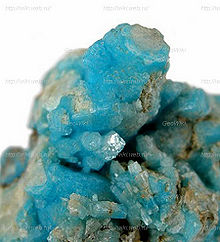|
|
|
Ледгиллит
 Ледгиллит, кристаллы до 0,7 см. в длину, Аризона, США Ледгиллит - минерал, сложный карбонат свинца с дополнительными анионами SO42- и OH-. Облик кристаллов псевдогексагонально-призматический, толсто- или тонкотаблитчатый, псевдоромбоэдрический. Двойниковые кристаллы обычны и весьма разнообразны. Агрегаты кристаллически-зернистые, плотные, скрытокристаллически-землистые. Под п. тр. вспучивается, плавится и желтеет, а при остывании белеет. В закр. трубке выделяет воду. С шипением растворяется в HNO3, давая осадок PbSO4.
Ледгиллит (англ. LEADHILLITE) - Pb4(SO4)(CO3)2(OH)2
| Молекулярный вес |
1,078.90 |
|---|
| Происхождение названия |
По местонахождению на м-нии Ледгилл (Шотландия). |
|---|
| IMA статус |
действителен, описан впервые до 1959 (до IMA) |
|---|
| Год открытия |
1832 |
|---|
КЛАССИФИКАЦИЯ
| Strunz (8-ое издание) |
6/B.13-50 |
|---|
| Dana (7-ое издание) |
17.1.2.1 |
|---|
| Dana (8-ое издание) |
17.1.2.1 |
|---|
| Hey's CIM Ref. |
12.2.11 |
|---|
ФИЗИЧЕСКИЕ СВОЙСТВА
| Цвет минерала |
бесцветный переходящий в белый, серый, желтоватый, бледно-зелёный переходящий в синий; бесцветный во внутренних рефлексах и напросвет. |
|---|
| Цвет черты |
белый |
|---|
| Прозрачность |
прозрачный, полупрозрачный |
|---|
| Блеск |
алмазный, смоляной, перламутровый |
|---|
| Спайность |
совершенная до весьма совершенной по {001} и легко получаемая. |
|---|
| Твердость (шкала Мооса) |
2.5 - 3 |
|---|
| Излом |
неровный |
|---|
| Отдельность |
трансляционное скольжение по {001}, также двойниковое скольжение с K1(340), σ2[140]; K2(34¯0), σ1[140]. |
|---|
| Прочность |
хрупкий |
|---|
| Плотность (измеренная) |
6.55 g/cm3 |
|---|
| Плотность (расчетная) |
6.57 g/cm3 |
|---|
| Радиоактивность (GRapi) |
0 |
|---|
| Термические свойства |
Heating results in a reversible transformation into susannite. 2E is approximately 20° (2V ~ 10°) at ambient temperature (for Na) and decreases with increasing temperature. It becomes одноосный negative at about 125° and remains so at higher temperatures. |
|---|
ОПТИЧЕСКИЕ СВОЙСТВА
КРИСТАЛЛОГРАФИЧЕСКИЕ СВОЙСТВА
| Точечная группа |
2/m - моноклинно-призматический |
|---|
| Сингония |
Моноклинная |
|---|
| Параметры ячейки |
a = 9.11Å, b = 20.82Å, c = 11.59Å
β = 90.46° |
|---|
| Отношение |
a:b:c = 0.438 : 1 : 0.557 |
|---|
| Число формульных единиц (Z) |
8 |
|---|
| Объем элементарной ячейки |
V 2198.21 ų |
|---|
| Двойникование |
Обычно двойники по (140); as lamellar twins with the composition plane parallel to {142} or {340}; as aragonite-type contact twins; as penetration twins; with other twin laws producing pseudoГексагональная groupings. |
|---|
Перевод на другие языки
 французский — Plomb carbonaté rhomboidal; Plomb sulfato-tricarbonaté французский — Plomb carbonaté rhomboidal; Plomb sulfato-tricarbonaté
 немецкий — Bleisulphotricarbonat; Leadhillit; Maxit; Psimythit; Schwefelkohlensaures Blei; Ternärbleierz немецкий — Bleisulphotricarbonat; Leadhillit; Maxit; Psimythit; Schwefelkohlensaures Blei; Ternärbleierz
 русский — Ледгиллит русский — Ледгиллит
|
 испанский — Leadhillita; Leadillita; Maxita испанский — Leadhillita; Leadillita; Maxita
 английский — Leadhillite английский — Leadhillite
|
Ссылки
Список литературы
- Bournon, Comte de (1817) Catalogue de la collection minéralogique particulière du roi, with atlas in fol., Paris: 343 (as Plomb carbonaté rhomboidal).
- Brooke (1820) Edinburgh Philosophical Journal, Edinburgh: 3: 117 (as Sulphato-tricarbonate of Lead).
- Beudant, F.S. (1832), Trailé élémentaire de Minéralogie, second edition, 2 volumes: 2: 366.
- Dufrénoy, A. (1847) Traité de minéralogie, 1st. Edition, Vol. 3: 152 (as Plomb sulfato-tricarbonaté).
- Glocker, E.F. (1847) Generum et specierum mineralien secundum ordines naturals digestorum synopsis. Halle: 256 (as Psimythit).
- Koksharov, N. von (1853) Materialien zur Mineralogie Russlands. 11 volumes with atlas: vol. 1: 76 (as Schwefelkohlensaures Blei).
- Laspeyres, H. (1872): Ueber die chemische Zusammensetzung des Maxit. - Journal für Praktische Chemie 5(1):470-476; Weinheim (as Maxite).
- Laspeyres (1872) Neues Jahrbuch für Mineralogie, Geologie und бледноontologie, Heidelberg, Stuttgart: 407, 508 (as Maxite).
- Laspeyres (1873) Neues Jahrbuch für Mineralogie, Geologie und бледноontologie, Heidelberg, Stuttgart: 292.
- Hintze (1874) Annalen der Physik, Halle, Leipzig: 152: 256.
- Laspeyres (1877) Zeitschrift für Kristallographie, Mineralogie und Petrographie, Leipzig: 1: 193.
- Artini (1890) Giornale di mineralogia, cristallografia e petrografia, Milan: 1: 1.
- Goldschmidt, V. (1890) Index der Krystallformen der Mineralien. 3 volumes, vol. 2: 301.
- Dana, E.S. (1892) System of Mineralogy, 6th. Edition, New York: 921.
- Pirsson and Wells (1894) American Journal of Science: 48: 219.
- Mügge (1901) Jb. Min., Beil.-Bd.: 14: 259.
- Palache, C. and LaForge (1909) Proceedings of the American Academy of the Arts and Sciences: 44: 435.
- Palache, C. and LaForge (1910) Zeitschrift für Kristallographie, Mineralogie und Petrographie, Leipzig: 48: 129.
- Goldschmidt, V. (1918) Atlas der Krystallformen. 9 volumes, atlas, and text, vol. 5: 133.
- Larsen, E.S. (1921) The Microscopic Determination of the Nonнепрозрачный Minerals, First edition, USGS Bulletin 679: 99.
- Hintze, Carl (1929) Handbuch der Mineralogie. Berlin and Leipzig. 6 volumes: 1 [3B]: 4243.
- Yosimura (1939) Journal of the Faculty of Science, Hokkaido University: 4: 453.
- Palache, C., Berman, H., & Frondel, C. (1951), The System of Mineralogy of James Dwight Dana and Edward Salisbury Dana, Yale University 1837-1892, Volume II: Halides, Nitrates, Borates, Carbonates, Sulfates, Phosphates, Arsenates, Tungstates, Molybdates, Etc. John Wiley and Sons, Inc., New York, 7th edition, revised and enlarged: 295-298.
- Mineralogical Magazine (1983): 47: 371-374.
- Giuseppetti, G., Mazzi, F. & Tadini, C. (1990): The crystal structure of leadhillite: Pb4(SO4)(CO3)2(OH)2. Neues Jahrbuch für Mineralogie, Monatshefte 1990, 255-268.
- Gaines, Richard V., H. Catherine, W. Skinner, Eugene E. Foord, Brian Mason, Abraham Rosenzweig (1997), Dana's New Mineralogy : The System of Mineralogy of James Dwight Dana and Edward Salisbury Dana: 520 (1997).
- K. Walenta, U. Kolitsch and T. Gulden (1997): On leadhillite and susannite with special regard to occurrences in the Black Forest. Aufschluss 48 (1), 59-64. (in German)
- Bindi, L. & Menchetti, S. (2005): Structural changes accompanying the phase transformation between leadhillite and susannite: A structural study by means of in situ high-temperature single-crystal X-ray diffraction. American Mineralogist: 90: 1641-1647.
|
|

